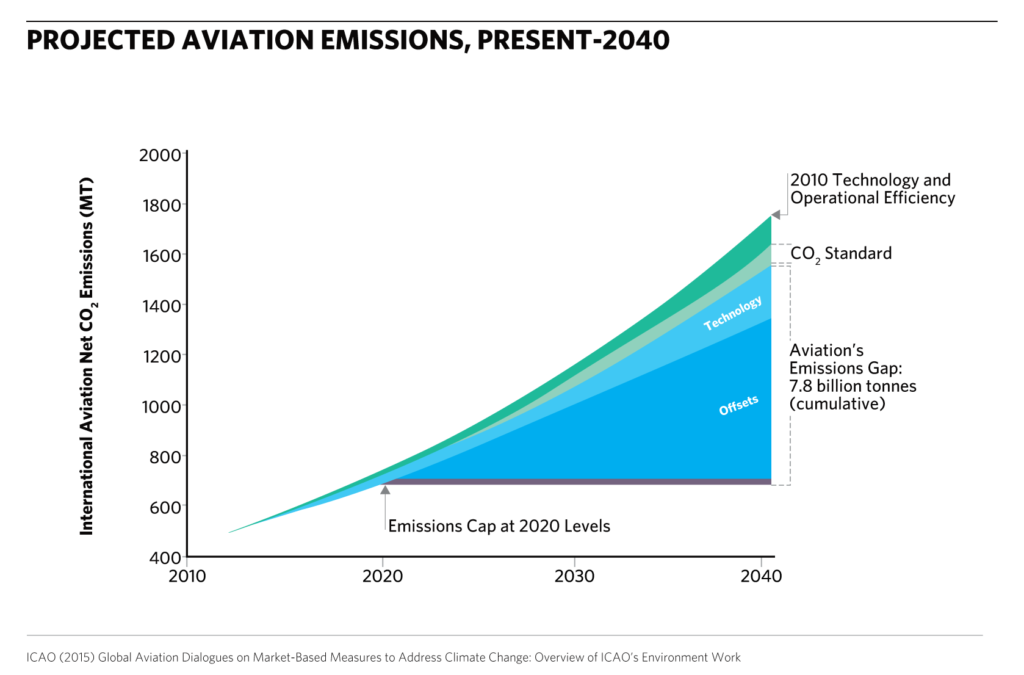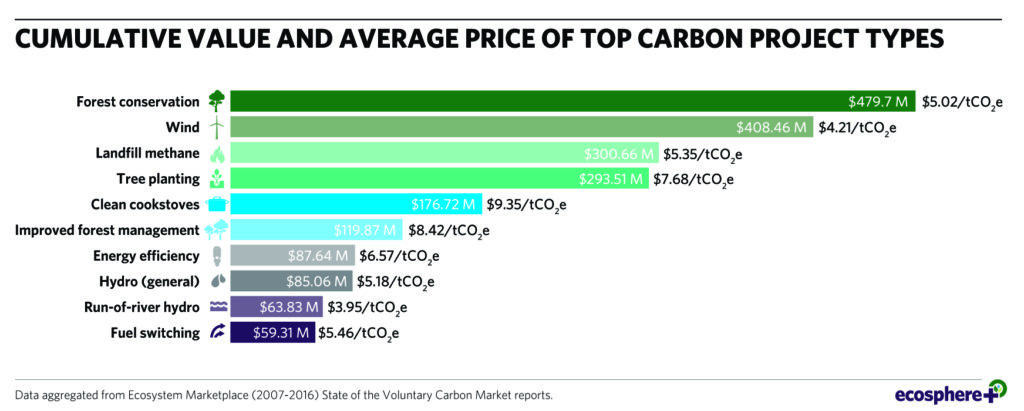In October 2017, a new peer-reviewed study came out led by scientists from The Nature Conservancy and 15 other institutions that expanded on the land-based climate solutions previously assessed by the United Nations’ Intergovernmental Panel for Climate Change (add source). The conclusion: Nature could cost-effectively deliver over a third of greenhouse gas emissions reductions required to hold global warming below 2 degrees Celsius by 2030. This is equivalent to a complete stop to the burning of oil worldwide.
What do forests as a climate solution have to do with an airline?
CORSIA is the Carbon Offsetting and Reduction Scheme for International Aviation that was reached in October 2016 to drive climate action in the aviation industry.
The demand for carbon offsets from CORSIA is substantive. It is estimated that airlines will generate an offset demand of 288 – 376 million tonnes (Mt) CO2e/year by 2030[1] (see graph). By comparison, the volume of offsets used in the EU ETS averaged approximately 202 MtCO2e over the period 2008-2012[2].
 Airlines will need access to offsets quickly. At the same time, demand for offsets is likely to increase as countries implement their Paris commitments. Emissions reductions from forestry have potential volumes in the gigatons. Forest conservation is the largest transaction volume within the existing voluntary carbon markets (see figure below) and is one of the most cost-effective types of carbon offsets, behind only solar and run-of-river hydropower, which may not be additional as countries start regulating their electricity sectors.
Airlines will need access to offsets quickly. At the same time, demand for offsets is likely to increase as countries implement their Paris commitments. Emissions reductions from forestry have potential volumes in the gigatons. Forest conservation is the largest transaction volume within the existing voluntary carbon markets (see figure below) and is one of the most cost-effective types of carbon offsets, behind only solar and run-of-river hydropower, which may not be additional as countries start regulating their electricity sectors.
The evidence is clear that forest carbon offsets have a large potential to meet CORSIA’s coming demand for offsets at a competitive price.

What about quality?
High quality forest carbon offsets are a well-established approach to achieving emissions reductions. Forest carbon offers real carbon reductions and their inclusion in the Paris climate agreement puts an official stamp of approval on them. The Paris climate agreement includes an internationally negotiated and agreed-upon framework that can be used for sustainable land use management and forest conservation. Forest conservation projects that deliver clear carbon benefits have come on long way in the last two decades and there are now well-practiced and robust methods for ensuring emissions savings are permanent.
For example, projects first perform detailed risk assessments to understand the threats to the forest. Secondly a buffer system is introduced that acts like an insurance mechanism. Then if forest land is found to be lost (as part of the intensive monitoring process), the corresponding number of offsets in this buffer are retired, meaning they are never placed on the market, ensuring the integrity of the offsets that are issued. Stringent standards also put safeguards in place to prevent leakage – leakage means the risk that deforestation is not fully prevented only moved to outside a project area, similar to the threat that refineries and other energy intensive industries would move outside of Europe once the EU ETS came along. To avoid and account for this in forest conservation projects, a detailed risk assessment informs a leakage mitigation strategy. The risk areas are then monitored and any leakage is deducted from the emission performance of the project.
The UN’s recommendations to avoid double-counting are anticipated next year. Countries are also working on national and jurisdictional level systems to account for every tonne of forest carbon; in time bottom-up projects can ‘nest’ into these top-down systems. The International Civil Aviation Organisation (ICAO) resolution that established CORSIA explicitly recognised the tools for mitigating emissions included in the Paris Agreement, such as REDD+ (mechanism for forest carbon) and the existing Clean Development Mechanism, a previous UN initiative through which countries purchase emissions reductions from developing countries[3]. Additionally, these offsets will need to meet the ‘emission unit criteria’ that is currently being developed by ICAO.

E+Transparency and Accountability
Not all offset projects are created equally. Over the years, a handful of poorly designed and executed forest carbon and other projects have had negative impacts on their local people and environment and, rightfully, have received bad press. However, these bad eggs are not representative of the potential or the usual practice. They do not prove that saving forests is not a climate solution that brings sustainable development to local communities and protects a host of critical environmental services.
It is standard for forest carbon offset project developers to verify the emissions reductions and additional benefits through third-party verifiers. The Verified Carbon Standard and the Climate Community and Biodiversity Alliance are leaders on carbon accounting and co-benefits respectively. They have detailed and sophisticated requirements to ensure that projects certified by them have lasting benefits and maintain environmental integrity.
Forest carbon offsets are also well-known to deliver a host of other benefits, such as contributing to the UN Sustainable Development Goals (SDGs). ATAG, the Air Transport Action Group, published Flying in Formation which recognised the many roles that aviation can play in supporting SDGs.
Ecosphere+ is a subsidiary of an impact fund, where we report on a host of other environmental and social indicators. There’s often a misconception that our job is done by just buying up land that has trees on it; in fact, we need to go much further and address the drivers of deforestation. Our Cordillera Azul project: has supported 27 community enterprises resulting in 738 jobs, conducted environmental education with 11,000 people from 25 communities, worked with three communities to improve over 2000 people’s access to healthcare, and we even discovered a new species in the forest we protect. These are engaging stories that can help you connect with your passengers.
We all know consumer preferences are changing: 83% would be more loyal to a company that helps them contribute to social and environmental issues.
Forest carbon offsets offer the most effective climate solution that the world has today to materially reduce emissions – and it’s also easily understood by consumers.
Today, there are 143 REDD+ projects globally on the VCS that have reduced 103 million tonnes – the equivalent of taking 22 million cars off the road for a year, or shutting 30 coal fire power plants for a year[4] (see table below).
Imagine how much more we can do if forests were part of CORSIA.
About the author, Ecosphere+:
Ecosphere+ is a mission driven new entity connecting people, businesses and governments to effective natural climate solutions that deliver environmental and social benefits. Founded by the Althelia Climate Fund we can offer scalable and diverse supply, and innovative structures, for different types of forest carbon offsets and sustainably produced commodities with innovative partnerships to deliver both on corporate and customer programmes.
If you would like to learn more about what we do or how airlines can be a part of the solution, contact: Jessica@ecosphere.plus or visit us at: ecosphere.plus.
[1] Forest Trends (2016) Rising Ambition: The State of the Voluntary Carbon Markets 2016 http://www.forest-trends.org/documents/files/doc_5242.pdf [2] European Commission. The EU Emissions Trading System (EU ETS)https://ec.europa.eu/clima/sites/clima/files/factsheet_ets_en.pdf [3] ICAO (2016) Resolution A39-3: Consolidated statement of continuing ICAO policies and practices related to environmental protection – Global Market-based Measure (MBM) schemehttp://www.icao.int/environmental-protection/Documents/Resolution_A39_3.pdf
[4] US EPA (2017) Greenhouse Gas Equivalencies Calculator. Accessed 1 December, 2017.https://www.epa.gov/energy/greenhouse-gas-equivalencies-calculator